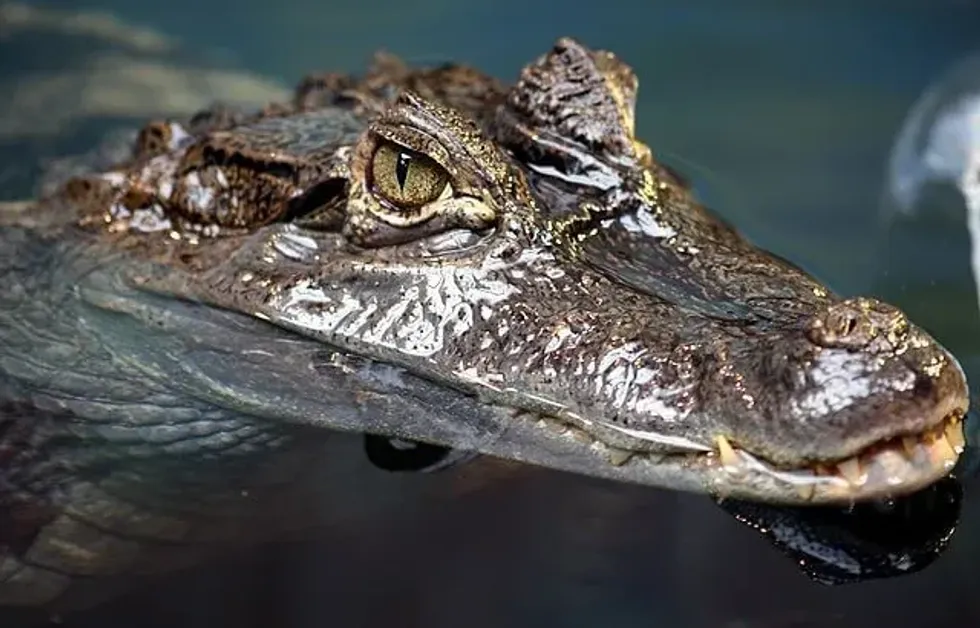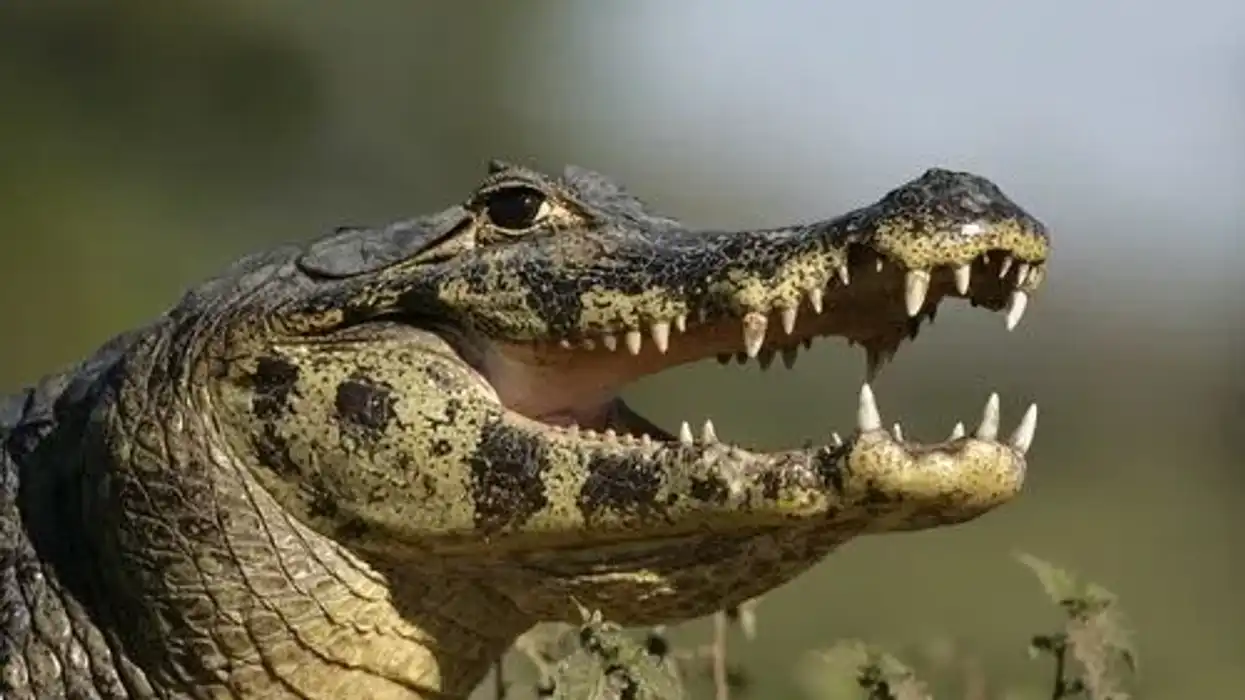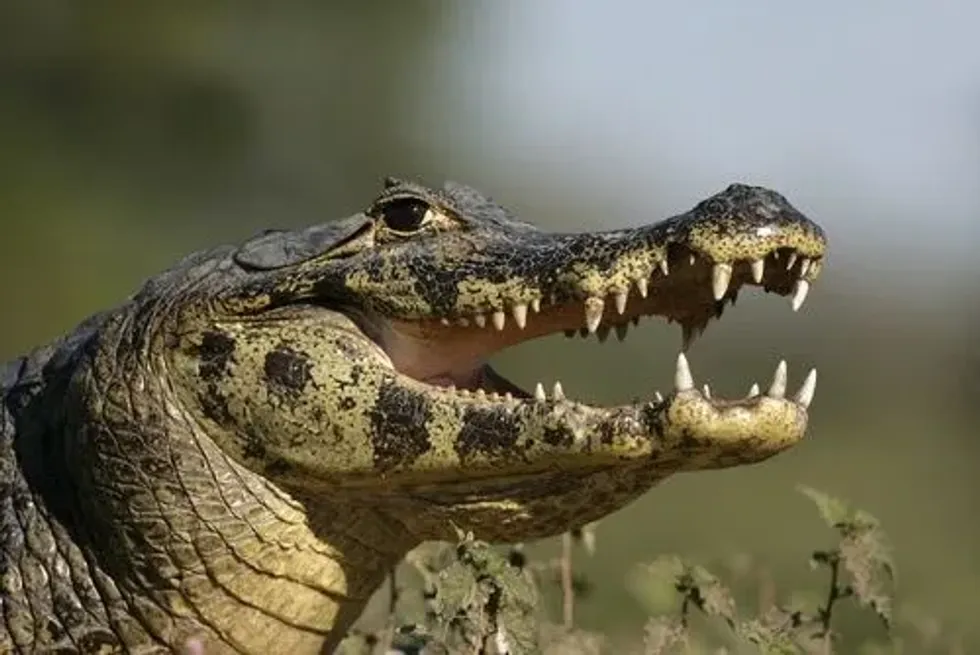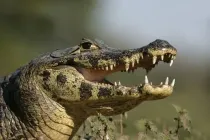Fun Spectacled Caiman Facts For Kids

The spectacled caiman (Caiman crocodilus) is a crocodilian species. A spectacled caiman lives in marshy wetlands, water bodies like rivers, shrublands, grasslands, and forests.
This species is found in plenty of regions in the continent of the Americas such as regions of Brazil, Costa Rica, Colombia, Ecuador, El Salvador, Cuba, and Puerto Rico. The caiman species are also found in Honduras, Mexico, Nicaragua, Panama, Peru, Suriname, Trinidad and Tobago, Venezuela, French Guiana, Guatemala, and Florida.
Spectacled caimans are nocturnal creatures. They are named spectacled caimans since there is a spectacle-like bony ridge between the eyes.
In this article, you'll find information such as how spectacled caiman's eggs are laid, the spectacled caiman's pair of spectacles, the species' infra orbital bridge, the spectacled caiman's mating season, spectacled caiman's breeding patterns, how spectacled caiman catch prey, the spectacled caiman's diet, and a lot more.
You may also check out our fact files on Chinese alligator and dwarf caiman from Kidadl.
Spectacled Caiman Interesting Facts
What type of animal is a spectacled caiman?
Spectacled caimans belong to the family of Alligatoridae and their binomial name is Caiman crocodilus. Spectacled caimans are one of the six species of caimans. It is crocodilian that is one of the native species of reptiles in North America, South America, Central America, El Salvador, and certain parts of the Caribbean.
What class of animal does a spectacled caiman belong to?
The spectacled caiman is a vertebrate animal that belongs to the class of Reptilia or reptiles. The class houses creatures like turtles, lizards, crocodiles, and tortoises.
How many spectacled caimans are there in the world?
According to the Red List of the IUCN, the number of spectacled caimans that are currently left in the region of Venezuela is around or below four million. It is expected to only surge in the future.
The number of spectacled caimans in the world cannot be estimated reliably in the current scenario. It can easily be said that the population of the species is in millions. The species of crocodile is not Endangered.
Where does a spectacled caiman live?
A spectacled caiman lives in marshy wetlands, water bodies like rivers, shrublands, grasslands, and forests. It is found in plenty of regions in the continent of the Americas.
These regions include South America, Central America, and North America. Caiman spectacled crocodiles are found in Brazil, Costa Rica, Ecuador, Colombia, El Salvador, Cuba, and Puerto Rico.
The caiman species are also found in Honduras, Mexico, Nicaragua, Panama, Peru, Suriname, Trinidad and Tobago, Venezuela, Guatemala, and Florida. It is not tolerant to extremely cold weather, thus it may not be found in the regions lying to the north of Florida.
In Brazil, caiman spectacled crocodiles are found in the rivers like Xingu, the Amazon, Rio Negro, Itapicuru, Araguaia, and Araguari.
What is a spectacled caiman's habitat?
Spectacled caimans usually prefer to live in low-lying areas where the water bodies are still and do not have active currents and rapids. They are found in rivers with floating flora and vegetation. The dense vegetation gives them the advantage of camouflaging efficiently. Caiman spectacled crocodiles live in rivers that flood and dry up seasonally.
The number of spectacled caimans in a particular region cannot be estimated easily. They tend to crawl out of their habitat during nighttime in order to hunt, particularly in the dry season. During the day they remain submerged in the water or live in hollow burrows that they dig around the surface of the rivers to make a habitat.
Who do spectacled caimans live with?
Spectacled caimans are nocturnal creatures and they are the most active at night. Ordinarily, the creatures roam and live in solitary. They can also form and live in loosely knitted groups and small to medium-sized gangs, swimming together or touching snouts.
How long does a spectacled caiman live?
Spectacled caimans can live in the range of 30-40 years in the wilderness. Their life expectancy could shorten in captivity. There are some studies showing some spectacled caimans living up to 60 years.
How do they reproduce?
Spectacled caimans reach the age of sexual maturity between four and seven years old. The dominant and aggressive males and females spectacled caimans tend to mature faster than others. At the time of maturity, the females could measure up to 4 ft (1.2 m), while the males could grow as long as 4.6 ft (1.4 m).
Generally, they grow 3-4 in (8-10 cm) per year. The mating season of spectacled caimans is from May to August. They choose mates and engage in copulation during the wet season of mating.
Spectacled caiman females build nests and dwellings for the purpose of laying eggs during the wet season after mating. The nest is not built during the winter season since the level of temperature is crucial for the sex of the young spectacled caiman, as well as, the survival of the eggs.
The home range is built on a mound of dense and thick vegetation by the females.
It is built near the surface of the river, but not too close that it becomes prone to being destroyed in the case of flooding. The eggs of spectacled caimans have a number of other threats apart from river flooding.
They can be preyed upon or destroyed by lizards belonging to the family of Tupinambis, as well as, other predatory animals.
Humans could destroy their nests and eggs too. Therefore, spectacled caiman females tend to always linger around and stay near their nest to protect the eggs.
Female spectacled caimans build their nests in such a way that they are insulated against extreme temperatures. The vegetation around the nests decays and provides warmth of up to 41 F (5 C).
The heat not only helps in incubating after the eggs are laid but also determines the sex of the young spectacled caiman. If the temperature is 90 F (32 C) or higher, the spectacled caiman common would be born as a female. Otherwise, they will be birthed as males.
The juveniles hatch after a period of about 90 days. 20-25% of the eggs successfully hatch and survive after mating. They are yellow in color with dark patches over their bodies. These color attributes fade as they grow older and mature.
They turn olive green with time. Young spectacled caimans measure around 8-10 in (20-25 cm) when they are born. Parents take care of the young spectacled caimans for about 12-18 months. In the first year, they are threatened by a lot of predatory animals and birds.
What is their conservation status?
The conservation status of spectacled caimans is Least Concern since this species of crocodiles is not endangered in the wild. However, poaching was an issue of concern during the '50s. Spectacled caimans were hunted by humans for their skin and for the pet trade.
Spectacled Caiman Fun Facts
What do spectacled caimans look like?
The spectacled caiman (Caiman crocodilus) is a crocodilian and belongs to the family of Alligatoridae. It is olive green, brown, yellow, and grayish in color. It has black crossbands and a black pigment all over its body.
The colors help this species to effectively camouflage. It helps them in protecting themselves from predators, as well as, when they hunt for their prey. They are named spectacled caimans since there is a spectacle-like bony ridge between the eyes, which looks like a pair of spectacles.

How cute are they?
The spectacled caiman (Caiman crocodilus) is a crocodilian, belonging to the family of Alligatoridae. They are predatory beings capable of fatally harming human beings. They hunt smaller animals, birds, and creatures.
Spectacled caimans have intimidating physical features like a large jaw lined with sharp, pointed teeth. The teeth of spectacled caimans and bite force are capable of ripping their prey into shreds. Caimans have about 72–76 teeth. There are no physical attributes that would be considered as cute.
How do they communicate?
Spectacled caimans communicate in a number of ways for different purposes. They have nine different vocalizations and 13 different visual tactics that they use to communicate.
Male spectacled caimans move their tails in a certain way by keeping them in vertical or arched positions. Female spectacled caimans give out different calls to keep young and juveniles spectacled caimans out of danger and away from predators.
Juveniles and young spectacled caimans give loud calls when they are in danger or in distress. When they want group cohesion, adults, as well as the young and juveniles spectacled caimans, make calls.
How big is a spectacled caiman?
The spectacled caiman (Caiman crocodilus) is a crocodilian. Spectacled caimans are smaller and lighter than one of the other species of common caiman like white caiman and brown caiman.
Black caimans are much larger and come across as relatively more intimidating. Spectacled caimans weigh 110 lb (50 kg) at most, but black caimans could weigh at least 1102 lb (500 kg). Black caimans can be as long as 13 ft (4 m), while spectacled caimans can be 4.6-8.2 ft (1.4–2.5 m) long.
How fast can a spectacled caiman move?
Spectacled caimans can move at a swift pace if they are hunting or hiding from predators. They are nocturnal and sly creatures who can move without tipping off their prey. They can move at a speed of about 25 mph (40 kph).
How much does a spectacled caiman weigh?
A spectacled caiman can weigh between 15-88 lb (7-40 kg). They could grow more than that too.
What are their male and female names of the species?
There are no separate terms to address the female and male counterparts of the species of common caiman.
What would you call a baby spectacled caiman?
There are no particular terms to refer to a baby spectacled caiman. They are called juvenile spectacled caimans.
What do they eat?
Spectacled caimans are carnivorous and predatory reptiles that have a diet of smaller animals, birds, amphibians, and insects. The diet includes freshwater crabs, insects, snails, small fish, certain types of birds, mammals, arachnids, myriapods, and reptiles.
Are they dangerous?
Spectacled caimans are predatory in nature and could be fatally harmful if they are provoked and threatened. They have excellent abilities to camouflage in situations of danger.
Would they make a good pet?
Spectacled caimans are wild reptiles that are capable of being harmful if they are provoked. They cannot be domesticated or kept as pets. However, they are captivated for commercial purposes.
Did you know...
Spectacled caimans were poached widely in the '50s till the '80s for their skin. Their dermis was exported globally.
To date, Venezuela has legalized the hunting of spectacled caimans for their skin, if the number does not decline below 150,000 in the wild. But in certain parts, their population has declined causing a reason of concern. In a number of countries, hunting of spectacled caimans is legal.
These animals have a tendency to adapt to any environment. Therefore, habitat loss does not affect their population or conservation status.
Although caimans and alligators are aggressive, they do not eat manatees.
How many eggs do caimans lay?
Spectacled caimans lay around 10-50 eggs during the mating season. The incubation period is 90 days. Around 20-25 % of these eggs survive and are hatched after the mating season. The young are prone to a lot of predators in the first year. Therefore, they are protected by their parents for 12-18 months in the wild.
Are caimans aggressive?
Spectacled caimans are relatively less aggressive than other members of the species like black caimans. They can become aggressive and territorial too if they are threatened or provoked. They move swiftly and in a quiet manner. They can camouflage and hide in the wild effectively.
These advantages make them trap their prey easily. They have a high prey drive and they are predatory in nature. Their bite force is estimated at 7 ton (6350 kg).
Here at Kidadl, we have carefully created lots of interesting family-friendly animal facts for everyone to discover! Learn more about some other reptiles from our Children's python facts and painted turtle facts pages.
You can even occupy yourself at home by coloring in one of our Spectacled Caiman coloring pages.
We Want Your Photos!
More for You
Bachelor of Arts specializing in English Literature

Akinwalere OlaleyeBachelor of Arts specializing in English Literature
As a highly motivated, detail-oriented, and energetic individual, Olaleye's expertise lies in administrative and management operations. With extensive knowledge as an Editor and Communications Analyst, Olaleye excels in editing, writing, and media relations. Her commitment to upholding professional ethics and driving organizational growth sets her apart. She has a bachelor's degree in English Literature from the University of Benin, Edo State.
Bachelor of Commerce specializing in Marketing and HR

Pradhanya RaoBachelor of Commerce specializing in Marketing and HR
With a Bachelor’s degree in Commerce from Christ University, Bangalore, Pradhanya's passion for the English language and literature led her to explore the field of content writing, where she has gained extensive experience in writing, reviewing, editing, and fact-checking. She has also earned certifications in Google Ads Search, Google Ads Display, and Social Media Marketing, showcasing her proficiency in digital marketing.
Disclaimer
1) Kidadl is independent and to make our service free to you the reader we are supported by advertising. We hope you love our recommendations for products and services! What we suggest is selected independently by the Kidadl team. If you purchase using the Buy Now button we may earn a small commission. This does not influence our choices. Prices are correct and items are available at the time the article was published but we cannot guarantee that on the time of reading. Please note that Kidadl is a participant in the Amazon Services LLC Associates Program, an affiliate advertising program designed to provide a means for sites to earn advertising fees by advertising and linking to Amazon. We also link to other websites, but are not responsible for their content.
2) At Kidadl, we strive to recommend the very best activities and events. We will always aim to give you accurate information at the date of publication - however, information does change, so it’s important you do your own research, double-check and make the decision that is right for your family. We recognise that not all activities and ideas are appropriate for all children and families or in all circumstances. Our recommended activities are based on age but these are a guide. We recommend that these ideas are used as inspiration, that ideas are undertaken with appropriate adult supervision, and that each adult uses their own discretion and knowledge of their children to consider the safety and suitability. Kidadl cannot accept liability for the execution of these ideas, and parental supervision is advised at all times, as safety is paramount. Anyone using the information provided by Kidadl does so at their own risk and we can not accept liability if things go wrong.
3) Because we are an educational resource, we have quotes and facts about a range of historical and modern figures. We do not endorse the actions of or rhetoric of all the people included in these collections, but we think they are important for growing minds to learn about under the guidance of parents or guardians.







